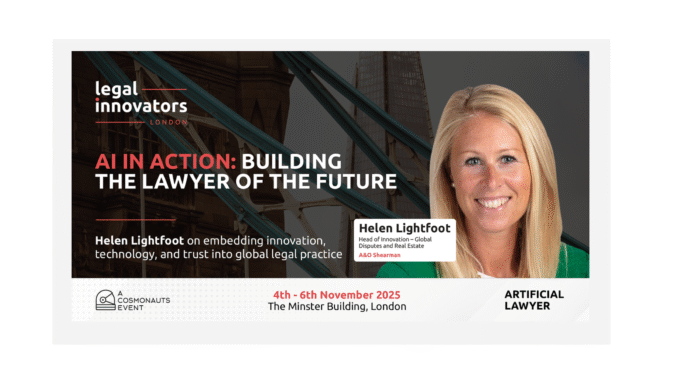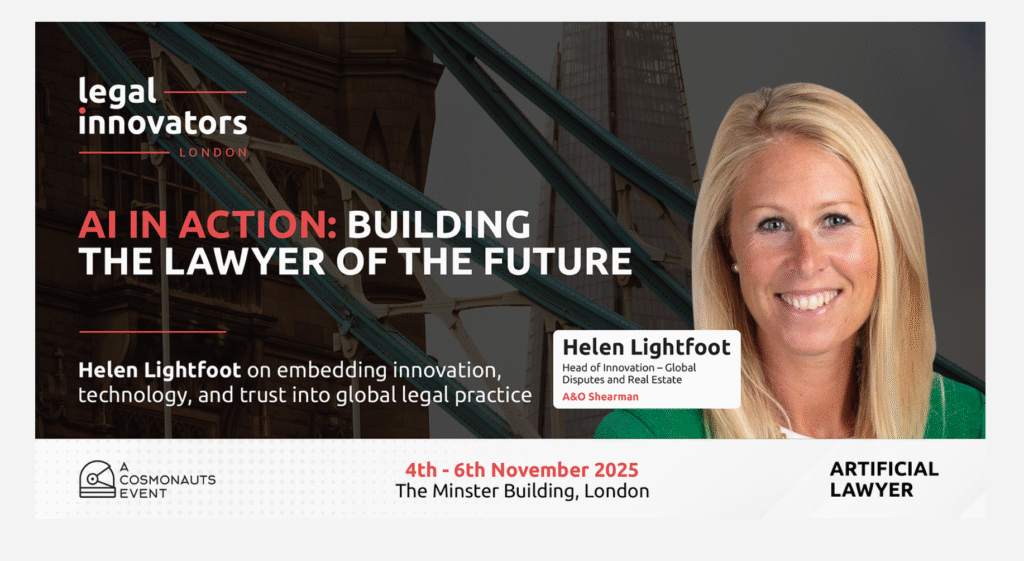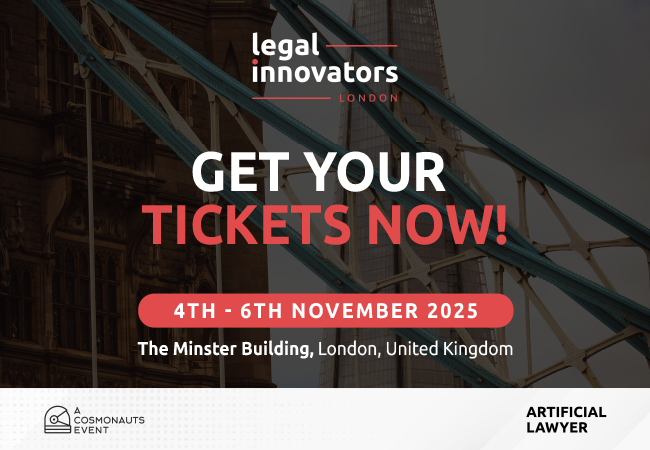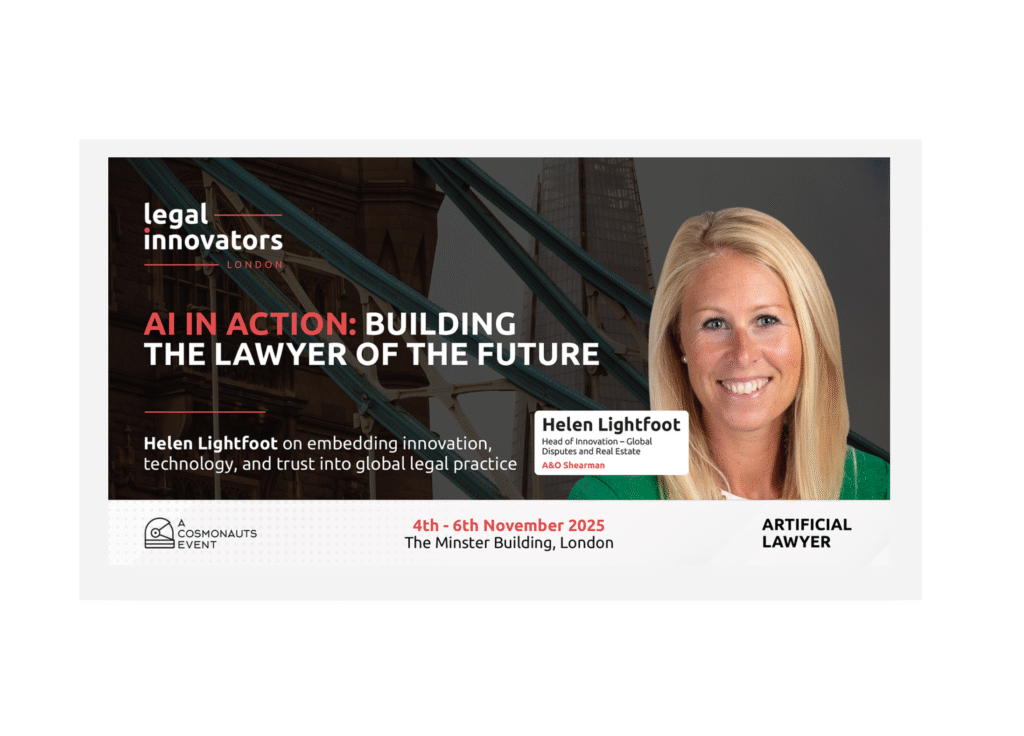
Ahead of the Legal Innovators UK conference on November 4, 5 and 6 in London, the team spoke to Helen Lightfoot, Head of Innovation, Global Disputes at A&O Shearman. Helen has been at the forefront of AI-driven transformation, helping one of the world’s leading law firms move from experimentation to real-world impact.
From embedding tools like ContractMatrix and Harvey into everyday practice, to equipping lawyers with the digital fluency they need, her work is about much more than technology. It’s about culture, trust, and leadership. Enjoy the interview below and see you at Legal Innovators UK!
From your perspective, how prepared are law firms currently for AI-driven transformation?
HL: Law firms’ preparedness for AI-driven transformation is highly variable. The most advanced firms have already integrated generative AI into their workflows, developed proprietary tools, and established robust governance frameworks. For example, A&O Shearman was the first law firm to implement generative AI globally in 2022, and has since launched proprietary solutions like ContractMatrix, which is now licensed to clients and used extensively in-house. These firms have also invested in AI-specific training, risk management, and compliance structures, positioning themselves as industry leaders and trusted advisors on AI matters.
There are some key challenges common across law firms to wide-spread AI-driven transformation. These include resource constraints – being able to invest in proprietary tools or comprehensive training as well as the fast past at which tools are developing. Cultural resistance can also be a factor where the legal industry’s traditional risk aversion and billable hour models can slow adoption.
While a select group of law firms are highly prepared for AI-driven transformation the sector as a whole is still in transition. The gap between leaders and laggards is widening, with preparedness hinging on investment in technology, training, and change management. As AI becomes a necessity rather than a differentiator, firms that fail to adapt risk losing competitiveness and client trust. The next few years will be critical as the industry moves from experimentation to systemic change, with preparedness increasingly defined by a firm’s ability to integrate AI responsibly, efficiently, and strategically.
In your opinion, what role does innovation leadership play in guiding lawyers through the digitalisation of the legal world?
HL: Innovation leadership is the catalyst that transforms digitalisation from a technical upgrade into a strategic, cultural, and client-focused evolution of legal practice. It provides the vision, structure, and support necessary for lawyers to navigate and thrive in the digital world, ensuring that technology serves as an enabler of excellence, not a disruptor of tradition.
Effective innovation leaders prioritise capability building ensuring that lawyers are not only aware of new technologies but are also equipped to use them responsibly and effectively. This includes comprehensive AI training and awareness programs, as well as the recruitment of talent skilled in prompt engineering and digital workflows.
Digitalisation in law is inherently multidisciplinary, requiring collaboration between lawyers, technologists, data scientists, and clients. Innovation leaders facilitate these collaborations, breaking down silos and encouraging knowledge sharing. The most successful legal innovators are those who can bridge the gap between legal expertise and technological capability, ensuring that solutions are both technically sound and legally robust.

Where do you personally see the balance between legal expertise and tech fluency?
HL: You need a balance of both and legal expertise remains the higher priority at the moment. It is the cornerstone of client trust and effective advocacy. The ability to interpret complex statutes, apply nuanced reasoning, and exercise sound judgment in ambiguous situations is irreplaceable. AI is an augmentative tool that enhances, but does not replace, the critical thinking and decision-making of experienced lawyers. At A&O Shearman, the policies require an ‘expert in the loop’ for all AI-generated outputs, ensuring that human oversight and legal judgment remain central to the process.
However, tech fluency is no longer optional. Lawyers must understand how to leverage AI tools such as Harvey, ContractMatrix, and RelativityOne to streamline research, automate drafting, and manage large-scale document reviews. This fluency extends beyond basic usage; it includes understanding the limitations, risks (such as hallucinations and data privacy), and governance requirements of these technologies. As the legal sector moves toward value-based billing and increased efficiency, those who can harness technology effectively will be better positioned to meet client expectations and remain competitive.
As Head of Innovation for Global Disputes and RE, how do you convince lawyers to embrace new tools? What resistance do you most often encounter, and how do you overcome it?
HL: Convincing lawyers to embrace new tools starts with empathy and ends with evidence. At A&O Shearman, we don’t push technology for technology’s sake, we translate fresh thinking into tangible business outcomes, whether that’s improving profitability, enhancing client satisfaction, or simply making the day-to-day easier for our teams.
The resistance we encounter is rarely about the tools themselves. It’s about time, trust, and relevance. Lawyers are busy. Their work is complex, high-stakes, and often reactive. So, when we introduce something new, the first question is always: ‘Will this help me right now?’
To answer that, we embed innovation into the work lawyers are already doing. For example, our proprietary tool, ContractMatrix, was designed with lawyers not just for them. It streamlines contract drafting, review, and negotiation, and is now used by over 1,900 lawyers across jurisdictions, delivering up to 30–50% time savings on form documentation.
We also maintain an ‘expert-in-the-loop’ model. AI doesn’t replace legal judgement, it enhances it. That’s a message that resonates. Lawyers want to know that their expertise remains central, and that tools like Harvey or ContractMatrix are there to support, not supplant.
Training is another key lever. We run drop-in sessions, cohort-based learning, and tailored demos. We also collaborate with vendors to ensure our lawyers understand not just how to use a tool, but when and why.
Ultimately, the most powerful way to overcome resistance is to show, not tell. We pilot tools in live matters, gather feedback, and iterate. We also share success stories internally, how a team used AI to accelerate due diligence or how a junior lawyer used ContractMatrix to confidently draft a clause.
How do you see the lawyer of the future balancing legal, technological, and business acumen?
HL: The lawyer of the future will be a multidisciplinary professional, blending legal expertise, technological fluency, and business insight to meet evolving client and market demands.
Legal knowledge and judgment remain foundational. Lawyers will continue to be responsible for ensuring the quality, accuracy, and ethical standards of legal work, even as AI and automation become more prevalent. The ‘expert in the loop’ approach where lawyers review and validate AI outputs will be essential to maintain trust and uphold professional standards.
The lawyer of the future will thrive by continuously learning, collaborating across legal, technical, and business teams, and delivering advice that is not only legally sound but also technologically informed and commercially relevant.Law firms that invest in these hybrid skills and foster cross-disciplinary collaboration will be best positioned for success.
–

What advice would you give to law students who fear being ‘replaced by AI’?
HL: AI is transforming legal work, but it is not replacing lawyers. It is automating repetitive tasks like document review and research, allowing lawyers to focus on higher-value, strategic work. Human skills such as critical thinking, ethical judgment, advocacy, and client relationships remain irreplaceable. The legal profession is fundamentally about problem-solving and understanding client needs, areas where AI cannot compete.
Law students should embrace technology, becoming comfortable with legal tech tools and understanding their limitations. The most successful lawyers will be those who are ‘AI-literate’ and can leverage these tools to deliver better outcomes. Adaptability and a commitment to lifelong learning are essential, as the legal industry continues to evolve.
Importantly, AI is also creating new opportunities in areas like AI governance, data protection, and tech-related legal advice. Firms like A&O Shearman always ensure an ‘expert in the loop,’ with lawyers overseeing and contextualising AI outputs. The future of law is a partnership between humans and machines, with human judgment at the centre.
What insights do you hope the audience will gain from your participation at Legal Innovators UK?
HL: I hope the audience walks away with a clearer sense of what innovation actually looks like in practice especially in the context of disputes and real estate. It’s easy to talk about transformation in abstract terms, but at A&O Shearman, we’re focused on translating fresh thinking into tangible business outcomes. That means showing how tools like Harvey, ContractMatrix, and RelativityOne are being used in live matters not just in pilots or proof-of-concepts .
I also want to demystify the role of innovation leads. We’re not just tech evangelists, we’re connectors. We bridge the gap between legal teams, clients, vendors, and technologists. Whether it’s helping a junior lawyer use AI to draft a clause under Dutch law, or collaborating with our Markets Innovation Group to test new tools in Fuse, our job is to make innovation feel accessible and relevant.
Another key insight I hope to share is around resistance. Lawyers are rightly cautious. Their work is high-stakes and client-facing. So we need to meet them where they are embedding tools into their workflows, offering tailored training, and showing how innovation can enhance rather than disrupt their expertise.
Finally, I want to highlight the importance of storytelling. Innovation isn’t just about tools, it’s about people. The success of our initiatives often hinges on internal champions, cross-functional collaboration, and a culture that supports experimentation. If attendees leave with a few real-world examples and a renewed sense of possibility, I’ll consider that a win.
—
On Private Practice Day (4th Nov), Helen will join the panel ‘Future-Proofing Legal Talent: Training Lawyers in the Age of AI’, exploring how firms can embed technology into strategy and prepare the next generation of lawyers.
Don’t miss the chance to hear from Helen and other industry leaders shaping the future of legal services. Passes are live – secure yours today.
Day One – Nov 4 – Private Practice Day
Day Two – Nov 5 – Inhouse Day
Day Three – Nov 6 – Litigation Day
—
Legal Innovators Conferences in London and New York – November ’25
If you’d like to stay ahead of the legal AI curve then come along to Legal Innovators New York, Nov 19 + 20 and also, Legal Innovators UK – Nov 4 + 5 + 6, where the brightest minds will be sharing their insights on where we are now and where we are heading.
Legal Innovators UK arrives first, with: Law Firm Day on Nov 4th, then Inhouse Day, on the 5th, and then our new Litigation Day on the 6th.


Both events, as always, are organised by the Cosmonauts team!
Please get in contact with them if you’d like to take part.
Discover more from Artificial Lawyer
Subscribe to get the latest posts sent to your email.

